 |
| October 23, 2012 | Volume 08 Issue 40 |
Designfax weekly eMagazine
Archives
Partners
Manufacturing Center
Product Spotlight
Modern Applications News
Metalworking Ideas For
Today's Job Shops
Tooling and Production
Strategies for large
metalworking plants
Sensors in the field:
Fiber-optic strain gages protect restoration of Milan cathedral
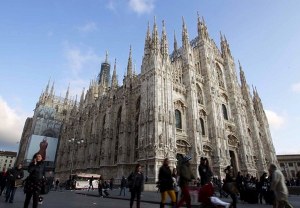
The Duomo di Milano is one of the largest cathedrals in the world.
By Dr. Alfredo Cigada - Politecnico di Milano
Located in Milan, Italy, the Duomo di Milano is one of the largest and most impressive Gothic structures in the world. Construction of the elaborate Duomo started in 1386 and continued for more than five centuries. In 1762, one of the main features of the Duomo, the main spire, or Guglia Maggiore, was erected at a height of 108.5 m and topped with the gold Madonnina statue of the Virgin Mary. In 2010, the Veneranda Fabbrica del Duomo, the organization in charge of the cathedral's preservation and maintenance, undertook the task of restoring the marble of the main spire, which was degraded by weather and pollution.
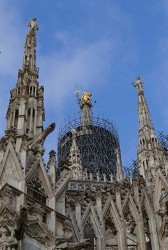
The recent restoration of the main spire required construction of a massive scaffolding structure.
This complex restoration required the construction of a massive scaffolding structure that completely envelops the main spire. This scaffolding weighs more than 90 tons, rests on the base of the cupola, is freestanding, and cannot make any contact with the spire walls. Concern over the additional weight of the scaffolding on the base of the cupola, along with the increased risk of higher wind loads, led the Veneranda Fabbrica del Duomo to contact the Politecnico di Milano to develop a reliable, continuous monitoring system that can monitor both the spire and the scaffolding. The Politecnico di Milano is a top technical university in Italy, and its mechanical measurements group has successfully deployed many structural health monitoring systems based on National Instruments (NI) platforms and NI LabVIEW system design software.
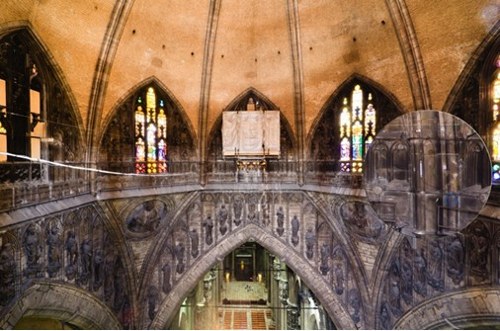
Optical long strain gage sensors are mounted on the ribs of the cupola.
Instrumenting the structure
The structure was instrumented with a variety of sensors to monitor wind conditions, the position and movement of the scaffolding and spire, and the load on the cupola. Because of the need for long-term reliable monitoring, and past experiences with lightning destroying previous instrumentation systems, the development team decided to use fiber Bragg grating (FBG) optical strain gages to monitor the load of the scaffolding on the cupola. Optical strain gages mounted on each of the eight ribs of the octagonal cupola, which supports the main spire, continuously monitor longitudinal deformation of the ribs. Each strain gage is accompanied by an FBG sensor for temperature compensation, and all sensors are multiplexed onto two optical fibers that are routed to the PXI Express system.
The scaffolding and spire are also instrumented with several displacement sensors to measure scaffolding movement relative to the spire, accelerometers to monitor the global dynamic behavior of the spire and scaffolding, linear variable differential transformers (LVDTs) to monitor crack openings, and anemometers to capture wind speed and direction.
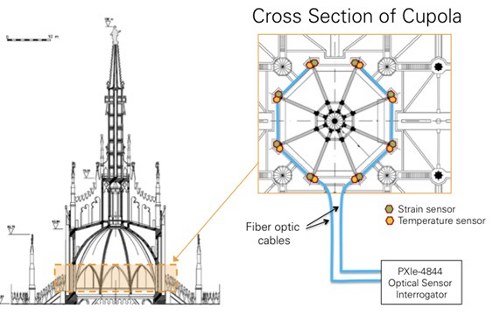
Layout of sensors and optical fiber in the cupola.
Real-time monitoring with PXI and LabVIEW
The PXI system, located in the bell room near the base of the cupola, includes the NI PXIe-4844 optical sensor interrogator, which acquires data from fiber-optic strain gages and temperature sensors and provides accurate, sensitive, and stable measurements. Currently, the system includes an NI CompactRIO chassis with NI 9234 dynamic signal acquisition (DSA) modules to acquire data from the electrical accelerometers and LVDTs. However, these sensors will eventually be ported over to the PXI system as well because the ability to combine both types of technologies in a single chassis is an important capability of the PXI platform.
The complete integrated PXI system is powered by LabVIEW Real-Time Module software for continuous, high-reliability operation that acquires sensor data and checks for unexpected structure behavior. If an anomaly is detected, an alarm is triggered both at the supervision screen and through an email sent to those in charge of the project. Data, which includes sensor self-diagnostics, is stored according to redundancy criteria and analyzed through a semiautomatic approach to detect any anomalous behavior. The most complex part of developing the system was determining the proper alarm levels based on both absolute criteria (actual wind gust speed) and the observed past behavior of the structure (past maxima and yearly changes).
Temperature compensation
The need to detect very small changes in mechanical strain on the cupola meant that any thermal effects caused by daily temperature cycles on the sensors and on the marble must be accurately compensated for. Therefore, the team set up a system in the Politecnico di Milano laboratory to fully characterize the thermal effects on the measurements. A sample block of marble and a mounted FBG strain sensor were put into an environmental test chamber. An NI PXIe-4844 collected data while the sample and sensor cycled repeatedly from -5 degrees C to 40 degrees C. The results were used to accurately remove all thermal effects on both the FBG and the marble material.
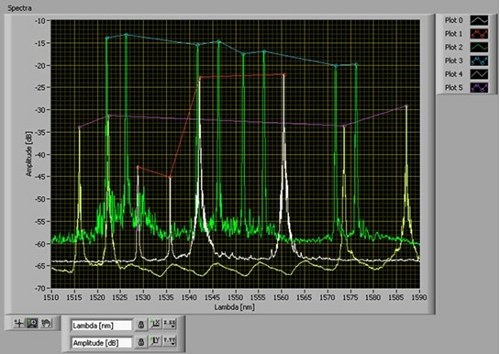
A snapshot of the measured optical spectrum shows reflected signal peaks from each of the FBG sensors.
Multimode system for 24/7 monitoring
The need for very stable measurements over long time periods as well as immunity to lightning were two key reasons for using the NI PXIe-4844 optical sensor interrogator and FBG sensors. The PXI system is now continuously monitoring the spire, cupola, and scaffolding through the integrated real-time measurement of both optical and traditional electrical sensors. In fact, the system is now considered a security system by the personnel working on the scaffolding, who have been trained to work with the software and interpret the output. This has proven to be very valuable, as demonstrated after the 2012 earthquakes in Northern Italy. Data collected by the monitoring system was a major help in assessing the integrity of the structures and validating that it was safe to resume restoration work on the spire.
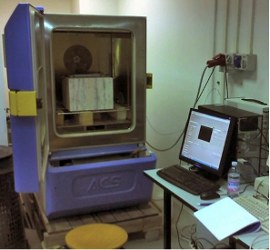
Extensive characterization of the thermal behavior of the marble material and the sensors was implemented in the Politecnico di Milano laboratory.
Click here for more information on NI fiber-optic sensing, fundamentals of FBG optical sensing, and optical-sensing solutions from National Instruments.
Source: National Instruments
Published October 2012
Rate this article
View our terms of use and privacy policy
